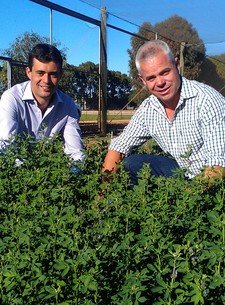'King of fodder’ will tap deep into farm potential
With autumn sowing upon us, now is the time for farm advisers and agronomists to be weighing up the benefits  of lucerne. This perennial legume has one of the best feed values going around. When established well, lucerne is high yielding and delivers an excellent source of protein, along with energy, minerals and vitamins to improve animal production.
of lucerne. This perennial legume has one of the best feed values going around. When established well, lucerne is high yielding and delivers an excellent source of protein, along with energy, minerals and vitamins to improve animal production.
It can be a vital ingredient in cattle or dairy production, to finish off prime lambs, improve fleece staple strength, flush ewes for improved lambing percentages or maintain breeding stock live weight over the summer months.
Lucerne’s ability to establish a deep tap-root system that explores many metres into the soil makes it a resilient and drought tolerant feed source.
Often referred to as the ‘king of fodder’, perhaps lucerne’s biggest feature is how it makes use of available soil water. Lucerne uses the stored soil moisture to extend the growing season of the feedbase by 1-3 months.
Powered by a big root system the “crown” produces new growth buds that quickly respond to recent rainfall. The plant is well adapted to make the most of spring, summer and autumn rain events and repeated growth will come from the crown for many years.
According to Alan Humphries, Principal Research Scientist at SARDI, growers considering planting lucerne need to match the variety to their needs.
SARDI and Barenbrug formed an alliance over 20 years ago to develop improved lucerne varieties for Australian farming systems. The breeding program has more than 60 trials spread across the country. Trial sites are located on commercial farms and are unfenced so they form part of the paddock. This makes sure testing is done under real commercial conditions; Australian soils, climate and management.
Alan said some excellent varieties to come from the national breeding program include SARDI-Grazer, SARDI 5, SARDI 7 Series 2 and SARDI 10 Series 2.
SARDI-Grazer is a new winter active variety developed in conjunction with the Department of Agriculture and Food WA with funding from GRDC. The focus was to increase the persistence of lucerne in mixed grazing/cropping systems where large paddocks limit the use of rotational grazing. SARDI-Grazer has now proven to be the most broadly persistent variety across all grazing systems in Australia.
SARDI 5 is best suited to farming systems where long term persistence, summer production and herbage quality are the most desired traits. It’s also suited to farms where winter production is either not wanted or is obtained from a mixed pasture sward.
Wherever SARDI 7 has proven successful, SARDI 7 Series 2 offers superior performance. This includes situations where persistent, high producing lucerne stands are required and in grazing situations where winter produced feed can be utilized. It is suited to direct grazing or hay and silage production and can be sown in pasture mixes or under-sown with cereals.
SARDI 7 Series 2 performs well in dairy, beef and sheep production systems in the high rainfall zones of south eastern Australia, where dormant or semi-dormant varieties have traditionally been grown. It will persist and produce more dry matter than winter or semi-winter dormant varieties, delivering more feed during the autumn and winter months when feed is in demand.
A new release from Barenbrug, SARDI 10 Series 2 benefits from excellent winter growth. During its development, the emphasis was on increasing forage production and quality, pest and disease resistance, persistence and grazing tolerance over popular variety - SARDI 10. A key SARDI 10 Series 2 feature is the greatly improved leaflet density down the length of each stem. SARDI Ten series 2 is the first choice for intensive production, where fast regrowth and high yield over the first three years are the key traits demanded from the system.
Barenbrug Research Manager, Allen Newman, said the nation-wide network of trial sites within the SARDI-Barenbrug lucerne germplasm evaluation program was instrumental in selecting the best breeding lines and comparing the performance of these lines against existing varieties. The result of such broad testing is that the SARDI series of lucerne varieties are the most broadly adapted in Australia, giving farmers the confidence of knowing the variety will work for them.
More information on the SARDI varieties is available from Barenbrug.

